Android-based Mail Management Information System in Desa Adat
on
JURNAL ILMIAH MERPATI VOL. 10, NO. 3 DECEMBER 2022
p-ISSN: 2252-3006
e-ISSN: 2685-2411
Android-based Mail Management Information System in Desa Adat
Awen Hariwijayaa1, Oka Sudanaa2, A.A.Ketut Agung Cahyawan Wiranathaa3 aInformation Technology Study Program, Faculty of Engineering, Udayana University, Bali e-mail: 1hariwijayaawen@gmail.com, 2agungokas@unud.ac.id, 3agung.cahyawan@unud.ac.id
Abstrak
Desa Adat merupakan salah satu lembaga yang bersifat tradisional di Bali. Hasil survei dan wawancara yang dilakukan pada Desa Pakraman Sesetan memberikan bukti bahwa kegiatan pengurusan dan pengarsipan surat masih dilakukan secara konvensional. Penelitian ini bertujuan untuk membangun sistem yang dapat meningkatkan efektivitas dari pengurusan surat menyurat pada Desa Adat. Penggunaan aplikasi berbasis Android memungkinkan pengguna untuk melakukan pengurusan surat dari mana saja dan kapan saja dengan tampilan yang dioptimalkan untuk perangkat telepon genggam. Sistem dikembangkan dengan menggunakan Framework Flutter pada bagian front-end dan Framework Laravel pada bagian back-end (API). Sistem diuji dengan menggunakan Metode Blackbox dan Metode PSSUQ. Hasil pengujian sistem dengan Metode Blackbox menunjukkan bahwa sistem sudah berjalan dengan baik. Hasil pengujian sistem dengan Metode PSSUQ menunjukkan bahwa sistem sudah dinyatakan baik.
Kata kunci: Desa Adat, Pengurusan Surat, Pengarsipan, Android
Abstract
Desa Adat is one of the traditional institutions in Bali. Based on a survey and interview in Desa Pakraman Sesetan gives proof that mail management and archiving are still done conventionally. This research’s purpose is to build a system that can increase mail management’s efficiency in Desa Adat. Android-based application allows its user to do mail management from anywhere and anytime with the phone-optimized user interface. System is developed using Flutter Framework on the front-end side and Laravel Framework on the backend side. System testing is done by using the Blackbox Method and PSSUQ Method. System testing’s result using Blackbox Method gives the fact that the system’s functionality already runs well. System testing’s result using PSSUQ Method gives the fact that the system has been declared good.
Keywords : Desa Adat, Mail Management, Archive, Android
Desa Adat is one of the traditional organizations in Bali. Desa Adat’s existence and its development have been recognized even before Indonesia was founded. Special acknowledgment of common law society, Desa Adat, and its traditional rights regulated in Pasal 18 B Ayat (2) Undang-Undang Dasar Negara Republik Indonesia Tahun 1945 [1]. Acknowledgment of Desa Adat confirmed in Peraturan Gubernur Daerah Provinsi Bali Nomor 4 Tahun 2019 about Desa Adat stated that Desa Adat is given the authority to organize and manage their government. Desa Adat or Desa Pakraman must provide service to the community (Krama Desa Adat) in their territory [2].
Desa Pakraman Sesetan is one of the Desa Adat that provides service in the form of adat mail management. Based on the survey and interviews that were conducted given the fact that mail management and archiving are still done conventionally. Mail management’s system became less effective and efficient because the letter-writing process is still done using Microsoft Word. Mail numbering system can’t be done automatically, because it must be adjusted with the number of letters issued pr
eviously, so Prajuru Desa Adat needs more time working on the letter until it’s verified by Bandesa Adat. Conventionally archived letters can’t last a long time, because this can create a buildup of archives and letters can be ruined as time goes by [3]. Conventionally archived letters can make seeking old letters can be difficult [4]. Desa Adat’s mail has its signature, usually the content of the letters is made using Balinese.
The purpose of this research is to make a mail management system that took an advantage of information technology and increases the effectiveness of mail management in Desa Adat. Information system usage may upgrade the mail administration process and allow every registered Desa Adat to do mail management more effectively and efficiently. Androidbased application usage surely could help users to do mail management from anywhere and anytime with the phone-optimized user interface.
Android-based mail management information system in Desa Adat (SiRada Android) is a system that can be used by the users to do mail management in Desa Adat using an Androidbased mobile device. Android-based mail management system in Desa Adat (SiRada Android) was done using Waterfall Method. Waterfall Method is a method that describes a systematic and sequential approach to the software development process [5]. Stages in the SiRada Android’s development process are shown in Figure 1.

Figure 1. Waterfall Method
Figure 1 shows the application development process. The development process carried out consists of 5 processes, which are Requirement, Design, Implementation, Verification, and Maintenance. The first step is to do a survey and interview in Desa Adat Pakraman Sesetan and do a literature study. A survey and interview are conducted to get an idea of mail management process. Literature study is done by looking for some articles (scientific articles, journals, or books) from the same research about mail management systems. The second step is designing a system. Designing the system process consists of designing the general idea of the system, designing Data Flow Diagram (DFD), and designing the database. A general idea of the mail management system in Desa Adat (SiRada) Android is shown in Figure 2.

Master Data Prajuru, Authentication Data, Incoming Mail Data, Outgoing Mail Data, Announcement Letter Data

Master Data Prajuru, Village Data, Account Data, Incoming Letter Data, Outgoing Letter Data, Agenda Data, Announcement Letter Data
Prajuru Desa Adat

Account Data. Outgoing Letter Data, Agenda Data. Announcement Letter Data
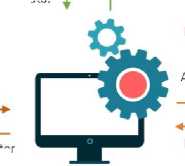
Android-based Mail Management Information System in Desa Adat
Master Data, Authentication Data, Incoming Letter Data, Outgoing Letter Data, Krama Data, Agenda Data, Announcement Letter Data
Master Data, Authentication Data, Outgoing Letter Data, Incoming Letter Data, Agenda Data.
Announcement Letter Data, Krams Data
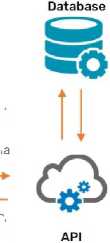
Account Data, Outgoing Letter □ata. Agenda Data, Announcement Letter Data

Account Data. Krama Data.
Announcement Letter Data, Agenda Data
Figure 2. General Idea of the System
Figure 2 shows the general idea of the mail management system in Desa Adat (SiRada) Android. The general idea of the system describes user entities involved in the system. Entities involved in the system consist of Prajuru Desa Adat, Committee, and Krama Desa Adat. Access owned by each of the entities is shown in Figure 2. Involved entities are shown in Table 1.
Table 1. User Entities
|
No |
Entities |
Description |
|
1 |
Prajuru Desa Adat |
Prajuru Desa Adat is a person that used the system to do mail management in Desa Adat. |
|
2 |
Krama Desa Adat |
Krama Desa Adat is a person that used the system to get information via outgoing mail intended for Krama Desa Adat and already verified by all persons. |
|
3 |
Committee |
Committee is a person that used the system to do mail management in the activity committee scope in Desa Adat. |
Designing the system process continues in designing the Data Flow Diagram (DFD). A Data Flow Diagram (DFD) is a diagram that shows the origin of the data and the destination of the data, the process that produces the data, and the interaction between saved data and the process of that data [6]. System’s Data Flow Diagram is represented by Context Diagram. A Context Diagram is a diagram that shows the data exchange between external entities and the system [7]. System’s Context Diagram is shown in Figure 3.
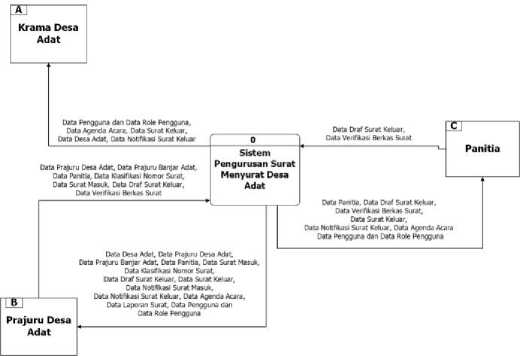
Figure 3. Context Diagram
The third step is developing the system. The system is developed after the designing process is done. System development is done by using Flutter Framework, Dart, Laravel Framework, PHP, and MySQL. Flutter Framework and Dart are used to develop the application on the front-end side. Flutter Framework is a cross-platform framework targeted at the mobile application and has a high performance [8]. Flutter Framework has a feature called Hot Reload that allows the developer to view changes in the application directly [9]. Dart Language is a programming language that is used in developing Flutter Framework applications [8]. Laravel Framework and PHP are used to develop the application on the back-end side or API. API (Application Programming Interface) is a technology that connects information exchange within 2 or more software and usually API used for windowing systems, file management, database, and networking system [10]. Laravel Framework is a framework that is used to develop an open-source website [11]. Laravel Framework used MVC (Model View Controller) framework which is already being a standard practice in application development [12]. PHP is one of the open-source script languages that usually runs on the server-side of the application [13]. MySQL is a SQL-based management system that is multithread and multi-user [14]. MySQL is one of the most used database servers in developing web applications that used the database as a data source [15].
The fourth step is testing the system. System testing is conducted by using Blackbox Method and PSSUQ Method. Blackbox Method is a system testing method by running some testing scenarios and checking the output from the app in purpose to check if the application already runs as expected [16]. PSSUQ (Post Study System Usability Questionnaire) Method is a method to review user’s satisfaction with the app [17]. Assessment by PSSUQ Method is divided into 4 categories, which are SysUse (System Usefulness), InfoQual (Information Quality), IntQual (Interface Quality), and Overall. SysUse category evaluates the user’s satisfaction with the system functionality and system benefits. InfoQual category evaluates the user’s satisfaction with the provided information by the system. IntQual category evaluates the user’s satisfaction with the interface of the system. Overall category evaluates the user’s satisfaction with the overall system [18]. PSSUQ Method system testing participants were given 16 questions about user satisfaction levels with the four categories in PSSUQ Method scoring using 1 point (strongly agree) until 7 point (strongly disagree) scale.
The final step is maintaining the system. System maintenance is done by fixing the system if a bug or error were found, or if a mistake were found within the system. Participant’s feedback within the business process that was not implemented yet is considered to be implemented inside the system, so the system will be more useful for the users.
Letter-making process in Sumberdem Village Office, Wonosari District, Malang Regency still uses the word-processing application, i.e. Microsoft Office, so the letter-making process still takes a long time and letter file recording is less organized, so a lot of problems show, like a lot of archive data loss or damage. Limited time needed to create a letter is one of
the reasons for developing this system. This research result is to produce a system that can make it easier to apply for Sumberdem Village residents’ letters by accessing the applications available in each RT/RW. [6]
Mail service process in Tanah Putih Village still required the citizens to come and wait for Headman to finish the letters, so this process takes up a long time, and if the Headman is not in the office this process can take even more time. This research result is to produce a system that can fix the weakness in administration service and help village officials in making the mail. [19]
Administrative data processing in Uma Sima Village Office is less optimal and efficient. Previous person data must be deleted first and the next person’s data added during the process of making the letters. Another obstacle founds in recording the incoming letters and outgoing letters is that still done manually and has not been computerized, so it will take time for employees and slow down the work of employees. This research result is to produce a system that can assist in making the letters, and recording the incoming and outgoing letters. This research shows that the usage of the information system can make the provided service to society more efficient. [20]
Letter-making process in Mendiro Village Office, Ngrambe District still uses the Microsoft Office application, but not all the employee has the same computer skill to make the letter, so administrative service depends on the certain administrative employee. Difference skills in the employee may be able to differentiate in letter format and accuracy in letter record is at risk. This research’s purpose is to make a system that can help in letter making process in the village and fix the problems that occur. System is tested using SUS Questionnaire (System Usability Testing). System testing result shows that system is in the usable category. [21]
The result and discussion section discuss the result of the system design implementation, system testing results, and system comparison analysis. The implementation of the system design is described in the form of application interfaces.
Application interface is designed according to the system design that has already been described previously. The application interface is designed to make it easier for the user to manage the data with the system. Authentication feature’s interface is shown in Figure 4.
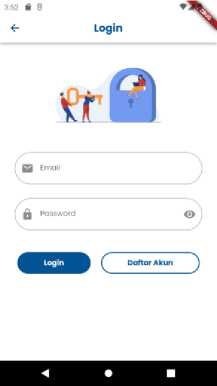
Figure 4. Authentication Feature
-
Figure 4 shows the interface of the Authentication Feature. Authentication Feature is used to make sure the user is already registered in the app and restrict the user’s access based on the user’s role before the user can use the system. Users can register themselves by choosing the Daftar Akun button and following the instruction provided on the app. Users can
continue the authentication process by choosing the Login button after inserting the Email and Password data. Incoming Letter Management Feature’s interface is shown in Figure 5.

Figure 5. Incoming Letter Management Feature
-
Figure 5 shows the interface of the Incoming Letter Management Feature. Incoming Letter Management Feature is a feature that can be used by Prajuru Desa Adat to manage the incoming letter data of Desa Adat. An incoming letter is a letter that is received by an instance and can be sent by another instance or a personal [22]. The data shown on this page is the letter’s event and the origin of the letter. The incoming mails added to the system will be automatically archived by the system. Outgoing Letter Management Feature’s interface is shown in Figure 6.
≡ O √ X
-
I Samua Tanggal Keluar I ( Sernua Kode Surot * J
. , Hari Raya Galungan
■■ OO2∕PHASSl∕vi∕2O2l
Surat Pengantar Edaran ...
002∕PHA-SST∕⅛1∣∕2022
O
^
-
Figure 6. Outgoing Letter Management Feature
Figure 6 shows the interface of the Outgoing Letter Management Feature. Outgoing Letter Management Feature is a feature that can be used by Prajuru Desa Adat or the committees in Desa Adat to manage the outgoing letter. An outgoing letter is a letter that is sent by an instance and filled with a message, announcement, or other information [22]. The outgoing letter that is shown is divided into 4 categories, which are Waiting for Response, In Progress, Already Confirmed, and Canceled. The submitted outgoing letter will be reviewed and verified by a verifier person. The filed outgoing letter will be automatically archived by the system. The letter verification process is done by adding the QR Code to the letter. A QR Code is a barcode that can store data or information and is intended to be scanned by the smartphone camera to gather information [23], [24]. The letter numbering process is already done automatically in the system. The verification letter process’s interface is shown in Figure 7.

(a)
(b)
Figure 7. (a) Letter Verification Action (b) Letter Verification Process (c) Reject Letter Verification
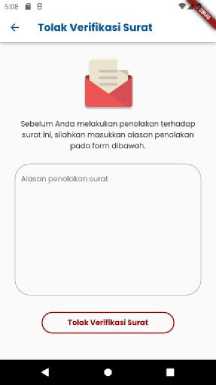
(c)
Figure 7 shows the letter verification process. Letter verification action can be done by choosing the Verifikasi Surat button in Figure (a). The rejection of letter verification can be done by choosing the Tolak Surat button in Figure (a). Figure (b) shows the interface which contains a confirmation of whether the user wants to verify the letter or not. Figure (c) shows the interface which contains the letter verification rejection form. Users are required to fill in the rejection reason in Figure (c). Letter verification process that was released by Prajuru Desa Adat starts from the Penyarikan or Village Secretary continued by the verification process by Bandesa Adat. The letter verification process is done by adding the QR Code to the letter. Verifier’s data page shows up after the user scans the QR Code in the letter. Event Agenda Feature’s interface is shown in Figure 8.

Figure 8. Event Agenda Feature
Figure 8 shows the interface of the Event Agenda Feature. Event Agenda Feature is a feature that can be used by the users to view event agenda data that is already registered on the system. The event agenda is a list of the activities that are held in Desa Adat at a certain time. Activity shown in the event agenda obtained from invitation letters for instance or it could be activities that are held by the internal Village Office. Activities data shown in the event agenda contains activity dates and activity time obtained from the incoming letter or outgoing letter. Announcement Letter Feature’s interface is shown in Figure 9.
Aganda Acara

Agenda Acara

5:35 β S
Gotong Royong di Pura Desa...

^wwi uu∣∙tfτσ^ ^mttπ^
Pengurnuman
I Cari pengumuman.»
Semua Tahun
Bulan
Nyanggra Tumpek Uye 301∕PDAS-SRg∕v∣∣∕2022
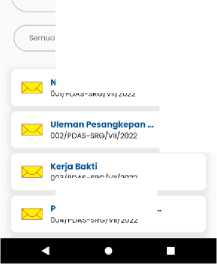
(a)
DESΛ ADAT SEANGAN
KECAMATAN DENPASAR SELATAN KOTA DENPASAR
JI. Tukad Punggawa. Serangan, Denpasar Sefctan108970146781
303/PDAS-SRG/VII/2022
Pembinaan bagi Krama... J04∕PPAS-SRG⅛ll∕2022
Serangan, 24-Jul-2022
Katur Majeng Ring:
Krama Desa AdiH Serangnn
Nomor: OOC√PDAS-SKG Vll 2022
Lcpihan: -
Panndikan: Golong Royong di Pura Desa Adac Serangan
⅞⅛¾}⅛'
Oni Snnstiynstu
Dengan Hormat,
Kami selaku Prujuru Desa Adat Serangari ingin mengundang BapaloTtrti seluruh Knuna Des□ Adai Serangan untuk menghadiri acara Gotong Ruyong Eviiiberssluin Pura Desa Adai Serangan yang akan dilaksanakan pada:
Hari1Tanggai: Sabtu. 30 Juli 2022
Waktu: 09.00 WITA sampai selesai

(b)
Figure 9. (a) Announcement Letter List (b) Announcement Letter Example
-
Figure 9 shows the interface of the Announcement Letter Feature. An announcement letter is an outgoing letter that has already been verified by all the verificator persons and is intended for Krama Desa Adat. Users can see the announcement letter list in Figure (a). Users can view the detail of the announcement letter in Figure (b).
Desa Adat mail management information system (SiRada) Android is tested using the PSSUQ Method (Post Study System Usability Questionnaire) and Blackbox Method. System testing using the Blackbox Method System is to check if the application is already working as expected. System testing using Blackbox Method shows that the application is already working as expected. System testing using the PSSUQ Method is to review user’s satisfaction when they’re using the application. The version of the PSSUQ Method used in this test is version 3 which contains 16 questions and uses a 1 point (strongly agree) until 7 point (strongly disagree) scale. System testing is conducted by Prajuru Desa Adat, students from Udayana University, and the public. System testing result by PSSUQ Method is shown in Figure 10.
|
R |
Question | |||||||||||||||
|
Q1 |
Q2 |
Q3 |
Q4 |
Q5 |
Q6 |
Q7 |
Q8 |
Q9 |
Q10 |
Q11 |
Q12 |
Q13 |
Q14 |
Q15 |
Q16 | |
|
R1 |
1 |
3 |
2 |
1 |
1 |
2 |
3 |
2 |
2 |
1 |
1 |
1 |
1 |
1 |
1 |
1 |
|
R2 |
2 |
2 |
1 |
2 |
3 |
2 |
2 |
1 |
2 |
2 |
3 |
2 |
1 |
2 |
2 |
2 |
|
R3 |
2 |
2 |
3 |
2 |
2 |
1 |
1 |
1 |
1 |
2 |
2 |
2 |
1 |
2 |
2 |
2 |
|
R4 |
2 |
1 |
3 |
1 |
1 |
1 |
1 |
1 |
2 |
1 |
1 |
1 |
1 |
1 |
1 |
2 |
|
R5 |
1 |
2 |
1 |
1 |
1 |
1 |
1 |
1 |
1 |
1 |
1 |
1 |
2 |
1 |
1 |
1 |
|
R6 |
1 |
1 |
2 |
1 |
1 |
1 |
1 |
1 |
1 |
1 |
1 |
1 |
1 |
1 |
1 |
1 |
|
R7 |
1 |
1 |
3 |
1 |
2 |
1 |
3 |
2 |
4 |
3 |
3 |
2 |
1 |
1 |
2 |
2 |
|
R8 |
3 |
2 |
1 |
3 |
1 |
2 |
3 |
1 |
1 |
2 |
3 |
1 |
1 |
1 |
2 |
2 |
|
R9 |
2 |
1 |
1 |
1 |
2 |
2 |
2 |
1 |
2 |
1 |
2 |
1 |
1 |
2 |
2 |
2 |
|
R10 |
2 |
3 |
3 |
1 |
1 |
3 |
2 |
1 |
1 |
1 |
2 |
1 |
1 |
2 |
2 |
1 |
|
R11 |
1 |
1 |
1 |
1 |
1 |
1 |
1 |
1 |
1 |
1 |
1 |
1 |
1 |
1 |
1 |
1 |
|
R12 |
2 |
3 |
2 |
3 |
2 |
3 |
2 |
3 |
4 |
3 |
4 |
4 |
4 |
4 |
4 |
4 |
|
R13 |
1 |
1 |
1 |
1 |
1 |
1 |
1 |
1 |
1 |
1 |
1 |
1 |
1 |
1 |
1 |
1 |
|
R14 |
4 |
4 |
4 |
5 |
4 |
4 |
4 |
5 |
4 |
5 |
4 |
3 |
4 |
4 |
3 |
4 |
|
R15 |
4 |
2 |
3 |
4 |
4 |
5 |
5 |
5 |
4 |
3 |
4 |
5 |
4 |
3 |
4 |
5 |
|
R16 |
2 |
2 |
3 |
2 |
3 |
3 |
3 |
2 |
2 |
3 |
2 |
2 |
3 |
3 |
3 |
2 |
|
R17 |
1 |
2 |
2 |
2 |
1 |
2 |
2 |
3 |
3 |
2 |
2 |
1 |
3 |
3 |
3 |
1 |
|
Avg |
1,88 |
1,94 |
2,12 |
1,88 |
1,82 |
2,06 |
2,18 |
1,88 |
2,12 |
1,94 |
2,18 |
1,76 |
1,82 |
1,94 |
2,06 |
2,00 |
|
Subscale |
System Usefulness (SysUse) |
Information Quality (InfoQuaI) |
Interface Quality (InterQuaI) |
Subscale | ||||||||||||
|
1,95 |
2,01 |
1,94 | ||||||||||||||
|
Overall |
1,97 | |||||||||||||||
-
Figure 10. PSSUQ Method Result
Figure 10 shows the system testing result using PSSUQ Method Version 3. System testing involved 13 respondents. The respondent contains 2 Prajuru Desa Adat, 12 students from Udayana University, and 3 public societies. R(n) column represents the respondent. Q(n) column represents the question. Avg column represents the average score of each question on
the Q(n) column based on the total respondent. PSSUQ Questionnaire produces 3 subscale points, which are SysUse, InfoQual, and InterQual, and also 1 overall point.
SysUse (System Usefulness) point was obtained from the respondent’s average response from question 1 until question 6 with the obtained score of 1,95 below the PSSUQ Method’s upper limit value. SysUse score shows that system is easy to use and easy to learn. InfoQual (Information Quality) point was obtained from the respondent’s average response from question 7 until question 12 with the obtained score of 2,01 below the PSSUQ Method’s upper limit value. InfoQual score shows that system is already good at giving the information to the users. InterQual (Interface Quality) point was obtained from the respondent’s average response from question 13 until question 15 with the obtained score of 1,94 below the PSSUQ Method’s upper limit value. InterQual score shows that the system has an appealing user interface. Overall score was obtained from the respondent’s average response from question 1 until question 16 with the obtained score of 1,97 below the PSSUQ Method’s upper limit value. Overall score shows that the overall system is good. [17]
System comparisons describe the comparison between this system and another similar system that has already been developed in previous research. System comparisons used 11 indicators and compared them with 4 similar systems. Android-based mail management information system in Desa Adat comparisons is shown in Figure 11.
|
Mail Management Administration System in Sumberdem Village Office |
Web-based Mail Service Application in Tanah Putih Village |
Mail Administration Management in Uma Sima District Office |
Android-based Mail Management System in Desa Adat | |
|
Authentication |
Support |
Support |
Support |
Support |
|
Incoming Letter Management |
Not Support |
Not Support |
Support |
Support |
|
Outgoing Letter Management |
Not Support |
Not Support |
Support |
Support |
|
Mail Administration Service Feature |
Support |
Support |
Support |
Not Support |
|
Letter Verification Feature |
Not Support |
Not Support |
Not Support |
Support |
|
Master Data Management |
Support |
Support |
Support |
Support |
|
Mail Report Feature |
Support |
Support |
Support |
Support |
|
Notification Feature |
Not Support |
Not Support |
Not Support |
Support |
|
Data Filter |
Not Support |
Not Support |
Not Support |
Support |
|
Event Agenda Feature |
Not Support |
Not Support |
Not Support |
Support |
|
Announcement Letter Feature |
Not Support |
Not Support |
Not Support |
Support |
Figure 11. System Comparisons
Figure 11 shows the comparison between the Android-based mail management information system (SiRada Android) and similar systems. The system that is used as a comparison is Mail Management Administration System in Sumberdem Village Office, Webbased Mail Service Application in Tanah Putih Village, and Mail Administration Management in Uma Sima District Office. Android-based mail management system in Desa Adat (SiRada Android) has a more complete feature in mail management scope. SiRada Android doesn’t have a mail administration service feature because this system is intended for Desa Adat, whereas mail administration service is usually conducted in Desa Dinas. SiRada Android has a unique feature, where Krama Desa Adat can see the announcement delivered by Prajuru Desa Adat and/or the committees. Another unique feature that this system has is users can see Desa Adat’s event agenda list within the system. SiRada Android is already integrated with all Desa Adat in Bali.
The designing process of the mail management information system is done by designing each module available in the system, assigning the users role, designing the database, and specifying each procedure within each module in the system. Android-based mail management has a few modules, which are the Incoming Letter Management Feature, Outgoing Letter Management Feature, and Event Letter Management Feature. User’s roles that are available in the system are Prajuru Desa Adat, Committee, and Krama Desa Adat. Development of the Android-based mail management information system was done by Flutter Framework with Dart on the application’s interface side and Laravel Framework with PHP on the API side.
The system was already tested using Blackbox Method and PSSUQ Method (Post Study System Questionnaire). System testing result with Blackbox Method shows that every functionality of this system runs well. System testing results with PSSUQ Method described the user’s review of the provided information (InfoQual), the system’s interface (InterQual), and the utility of the system (SysUse). System testing result with PSSUQ Method gives the conclusion that provided information, application interface, user’s satisfaction with the system, and the overall system was declared good because the obtained score was below PSSUQ Method’s upper limit value. System was able to solve the mail numbering system problems and the letters created within the application are automatically archived.
References
-
[1] H. Hasanah, “OTONOMI DESA ADAT PAKRAMAN BERDASARKAN PERATURAN
DAERAH PROVINSI BALI NOMOR 4 TAHUN 2019 TENTANG DESA ADAT DI BALI,” vol. 5, no. 1, pp. 58–74, 2021.
-
[2] D. I. W. G. Wiryawan, D. I. K. S. L. P. Perbawa, and L. Julianti, “INOVASI PELAYANAN
PUBLIK BERBASIS TEKNOLOGI INFORMASI DAN KOMUNIKASI BERDASARKAN NILAI KEARIFAN LOKAL BALI,” pp. 87–100, 2018.
-
[3] M. Hatta, M. M. Anwar, I. N. Diana, and M. H. Amarul M, “Perancangan Sistem Informasi
Pengarsipan Dan Disposisi Surat Berbasis Web Dengan Menggunakan Framework Codeigniter,” SCAN - J. Teknol. Inf. dan Komun., vol. 14, no. 2, 2019, doi: 10.33005/scan.v14i2.1481.
-
[4] P. Irawan, D. A. P. Prasetya, and P. Sokibi, “Rancang Bangun Sistem Pengarsipan
Surat Kedinasan Berbasis Web Menggunakan Framework Codeigniter,” J. Manaj. Inform. dan Sist. Inf., vol. 3, no. 2, pp. 157–165, 2020.
-
[5] A. A. Wahid, “Analisis Metode Waterfall Untuk Pengembangan Sistem Informasi,” J.
Ilmu-ilmu Inform. dan Manaj. STMIK, no. November, pp. 1–5, 2020, [Online]. Available: https://www.researchgate.net/profile/Aceng_Wahid/publication/346397070_Analisis_Met ode_Waterfall_Untuk_Pengembangan_Sistem_Informasi/links/5fbfa91092851c933f5d76 b6/Analisis-Metode-Waterfall-Untuk-Pengembangan-Sistem-Informasi.pdf.
-
[6] O. S. Rifai, F. Amrullah, and R. David, “PERANCANGAN SISTEM INFORMASI
PENGELOLAAN ADMINISTRASI SURAT MENYURAT DI KANTOR DESA SUMBERDEM KECAMATAN WONOSARI KABUPATEN MALANG,” Semin. Nas. Sist. Inf. 2018, 9 Agustus 2018 Fak. Teknol. Inf. – UNMER Malang, vol. 2, no. 1, pp. 1229– 1238, 2018, [Online]. Available: https://jurnalfti.unmer.ac.id/index.php/senasif/article/download/186/155.
-
[7] W. Hardinugraha, O. Sudana, and D. P. Githa, “Web-Based E-Marketing Application for
Balinese Art Studio,” J. Ilm. Merpati (Menara Penelit. Akad. Teknol. Informasi), no. May, p. 34, 2021, doi: 10.24843/jim.2021. v09.i01.p04.
-
[8] A. Tashildar, N. Shah, R. Gala, T. Giri, and P. Chavhan, “Application Development Using
Flutter,” Int. Res. J. Mod. Eng. Technol. Sci. @International Res. J. Mod. Eng. , no. 08, pp. 2582–5208, 2020, [Online]. Available: www.irjmets.com.
-
[9] F. D. Astuti and Y. Hermawan, “PEMANFAATAN FIREBASE REALTIME DATABASE
PADA APLIKASI PEMBELAJARAN AGAMA ISLAM MENGGUNAKAN FRAMEWORK FLUTTER,” vol. 18, pp. 1–11, 2020.
-
[10] A. Hanafi, I. M. Sukarsa, and A. A. K. Agung Cahyawan Wiranatha, “Pertukaran Data Antar Database Dengan Menggunakan Teknologi API,” Lontar Komput. J. Ilm. Teknol. Inf., vol. 8, no. 1, p. 22, 2017, doi: 10.24843/lkjiti.2017.v08.i01.p03.
-
[11] I. G. Handika and A. Purbasari, “Pemanfaatan Framework Laravel Dalam Pembangunan
Aplikasi E-Travel Berbasis Website,” Konf. Nas. Sist. Inf. STMIK Atma Luhur Pangkalpinang, pp. 1329–1334, 2018.
-
[12] A. F. Ibrahim, N. Musa, and M. N. F. Jamaludin, “Internship Application System (IAS) for University Students using Laravel,” J. Comput. Res. Innov., vol. 3, no. 4, pp. 12–18, 2018, doi: 10.24191/jcrinn.v3i4.85.
-
[13] R. Hermiati, A. Asnawati, and I. Kanedi, “Pembuatan E-Commerce Pada Raja Komputer Menggunakan Bahasa Pemrograman Php Dan Database Mysql,” J. Media Infotama, vol. 17, no. 1, pp. 54–66, 2021, doi: 10.37676/jmi.v17i1.1317.
-
[14] A. Suryadi and Y. S. Zulaikhah, “Rancang Bangun Sistem Pengelolaan Arsip Surat Berbasis Web Menggunakan Metode Waterfall (Studi Kasus : Kantor Desa Karangrau Banyumas),” J. Khatulistiwa Inform., vol. 7, no. 1, pp. 13–21, 2019, doi: 10.31294/jki.v7i1.36.
-
[15] P. Fitriah, “Perancangan Sistem Surat Menyurat Unit Kesehatan Masyarakat (Ukm) Berbasis Dekstop Di Puskesmas Sukabangun,” 2018.
-
[16] F. C. Ningrum, D. Suherman, S. Aryanti, H. A. Prasetya, and A. Saifudin, “Pengujian Black Box pada Aplikasi Sistem Seleksi Sales Terbaik Menggunakan Teknik Equivalence Partitions,” J. Inform. Univ. Pamulang, vol. 4, no. 4, p. 125, 2019, doi: 10.32493/informatika.v4i4.3782.
-
[17] R. Suwandy and S. Hadini Marpaung, “Evaluasi Pengalaman Pengguna dengan Menggunakan Post Study System Usability Questionnaire (PSSUQ) Perpustakaan Digital Universitas Mikroskil,” J. Pendidik. Tambusai, vol. 6, pp. 4190–4206, 2022,
[Online]. Available: https://www.mikroskil.ac.id/pustaka.
-
[18] H. Abiwardani, B. T. Hanggara, and B. S. Prakoso, “Evaluasi Usability Aplikasi Usaha Laundry Berbasis Web Menggunakan Metode Usability Testing (Studi Kasus: Aplikasi Smartlink Bos),” J. Pengemb. Teknol. Inf. dan Ilmu Komput. , vol. 4, no. 3, pp. 822–829, 2020, [Online]. Available: http://j-ptiik.ub.ac.id.
-
[19] S. Ramadhani, F. Hermawanto, and A. Mariani, “Aplikasi Pelayanan Surat Menyurat Desa Tanah Putih Berbasis Web,” J. Teknol. Inf. Indones., vol. 3, no. 2, p. 54, 2019, doi: 10.30869/jtii.v3i2.265.
-
[20] E. Oktaviani, Rodianto, S. Noviana, and Nawassyarif, “Rancang Bangun Sistem Informasi Untuk Meningkatkan Tata Kelola Administrasi Surat Menyurat,” J. Inform. Teknol. dan Sains, vol. 2, no. 3, pp. 203–207, 2020, doi: 10.51401/jinteks.v2i3.757.
-
[21] A. D. Rahmawati and A. Fatmawati, “Sistem Administrasi Desa Mendiro Kecamatan Ngrambe Kabupaten Ngawi berbasis Web,” Emit. J. Tek. Elektro, vol. 20, no. 02, pp. 149–155, 2020, doi: 10.23917/emitor.v20i02.9893.
-
[22] N. Ikhsan and S. Ramadhani, “Sistem Informasi Administrasi Surat Menyurat Kantor Wilayah Kementerian Agama Provinsi Riau,” J. Teknol. Dan Sist. Inf. Bisnis, vol. 2, no. 2, pp. 141–151, 2020, doi: 10.47233/jteksis.v2i2.126.
-
[23] M. Ismail, A. Ghazali Syam, and M. Masnur, “APLIKASI QR CODE SEBAGAI SARANA PENYAMPAIAN INFORMASI POHON DIKEBUN RAYA JOMPIE,” J. Sintaks Log., vol. 1, no. 1, pp. 2775–412, 2021, [Online]. Available: https://jurnal.umpar.ac.id/index.php/sylog.
-
[24] J. Dedy irawan and E. Adriantantri, “Pemanfaatan Qr-Code Segabai Media Promosi Toko,” J. Mnemon., vol. 1, no. 2, pp. 56–61, 2019, doi: 10.36040/mnemonic.v1i2.39.
Android-based Mail Management Information System in Desa Adat (Awen Hariwijaya)
132
Discussion and feedback